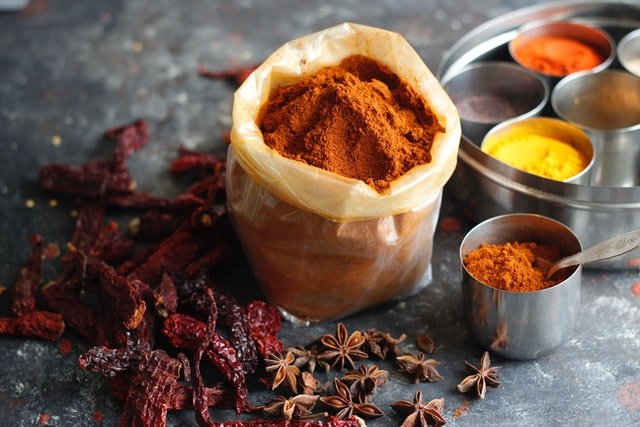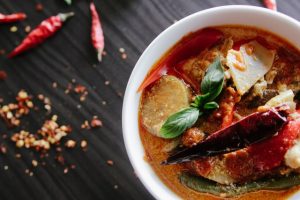Crushed red pepper is not the same thing as ground red pepper. Crushed red pepper is made by taking whole peppers and smashing them up so they release the oils that make them spicy. The resulting powder will be much hotter than the ground pepper you usually find in the grocery store.
Taste is relative, so what we’re really talking about are Scoville heat units. Specialists rate peppers on the Scoville scale, with zero for no heat up to 500,000 for pure capsaicin (the chemical that makes peppers hot). Capsaicin is 300 times more concentrated in the hottest part of the pepper – the membranes between the seeds and ribs – than in other parts of it.
Crushed red pepper will be at least 50 to 100 times more spicy than your average supermarket variety. That doesn’t mean you should put 50 times as much on your pizza or burgers; heat fades with cooking, so you don’t want to go overboard.
The Scoville Scale is a measurement of how much capsaicin is in a chili pepper. Capsaicin is the chemical that causes all the “heat” in peppers, and thus is responsible for the scale. The more capsaicin there is in a pepper, the higher its Scoville rating will be.
Tobasco sauce for example, has a rating of 2,500-5,000 Scoville Heat Units (SHU). Pepper spray rates at around 5,000,000 SHU.
It’s important to note that not all members of the pepper family have capsaicin, which means they have no “heat.” Take bell peppers for example: they have no capsaicin at all and therefore no measurable Scoville rating.
The Scoville Scale was invented by Wilbur Scoville in 1912 as a way to measure pepper heat in order to aid his work as a pharmacist. His method involved diluting pepper extract with sugar water until the “heat” was gone and then measuring how many parts sugar water it took to dilute away the heat. From that he could estimate the original number of parts pepper extract it took to neutralize the extract. This measurement was then converted into the familiar scale we know
The Scoville scale is used to measure the amount of capsaicin in a given food. The higher the Scoville number, the hotter the pepper. The scale is named after its creator, Wilbur L. Scoville. Capsaicin is what gives peppers their kick, and it’s measured in Scoville Heat Units.
The original test for SHU was created by Dr. Wilbur Scoville in 1912. He mixed the pepper extract with sugar water and gave it to a panel of five people. The people were then asked to eat increasing amounts of this mixture until they reached a point where they could no longer tolerate the heat. Sugar water was chosen as a medium because it had no flavor or odor of its own; therefore, any heat detected would be due solely to the capsaicin in the peppers.
A standard amount of dilution was used for all peppers: an amount equal to 100 times the weight of pure capsaicin present in 1 gram of sample—though not all peppers are measured by weight and some are measured by volume instead (as shown in this table). So, if a pepper has an SHU rating of 500, that means that it contains .05% pure capsaicin and requires 5,000 parts
The Scoville Scale was invented by a scientist named Wilbur Scoville in 1912. He put a drop of pure capsaicin, the active ingredient in chili peppers, on a pepper and diluted it with sugar water until it had no more effect on a panel of five testers. Then he kept diluting it until the testers could barely detect any heat at all. He determined that there was one part capsaicin for every 16 parts sugar water. The resulting measurement is known as Scoville Heat Units or SHU’s.
Tested this way, the hottest chili pepper in the world has about 577,000 heat units, but other methods have set it as high as two million SHU’s. Pure capsaicin is rated an amazing 15-16 million units. The hottest pepper you can buy in a grocery store is only about 500 SHU’s which is hotter than a jalapeno but about half the heat of a habañero.
SHU’s are useful to know when dealing with foods that include chili peppers or if you’re searching for something to add some kick to your food without being too hot to handle. You’ll need to know both the rating and the amount used because different chilis have different levels of caps
The Scoville Scale is used to measure the hotness of chili peppers. One reason why it’s so fun is because there’s no official set of rules. You can’t just throw something into a test tube and get an answer like you would for the pH scale, for example. It’s really about how your taste buds interpret the pepper’s spiciness.
Testers use every tool imaginable — sight, smell, touch, and taste — to determine the heat level of a chili pepper. The more factors they can use to determine the level of heat, the more accurate their measurements will be.
The Scoville Scale is named after its creator, American pharmacist Wilbur Scoville (1865-1942). He was trying to solve a problem that had bedeviled scientists since time immemorial: How do you make sense of something as subjective as spicy food?
The Scoville scale, invented by Wilbur Scoville in 1912, is a way to measure how spicy something is. The method of measuring the “heat” is actually pretty simple: dissolve a sugar solution and then dilute it with water.
The more sugar dissolved in the water, the less spicy the pepper will be. If there is no sugar at all, then the pepper will have no heat.
The Scoville Scale is a measurement of the pungency (spicy heat) of chili peppers. The scale is named after its creator, American pharmacist Wilbur Scoville, who formulated the scale in 1912.
The heat of a chili pepper is due to the chemical capsaicin and its related capsaicinoids, the most important of which are capsaicin and dihydrocapsaicin. The amount of capsaicin in a pepper is measured in Scoville Heat Units (SHU). Pure capsaicin has an SHU rating of 16 million–16 billion.
Taste testers use their senses of sight, smell, and taste to determine how hot a particular food sample is. Quantification of pungency is based upon the ratings given by these taste testers; therefore, the results may be influenced by human subjectivity. To make comparisons between different chilis more objective, researchers often use high performance liquid chromatography (HPLC) to directly measure the amount of capsaicin present in a particular sample instead of relying on sensory analysis.
The results of these measurements can be used to predict how much capsaicin will be produced by a plant when grown under varying conditions.
Unripe fruit tends to have

